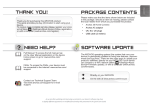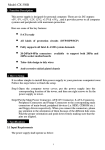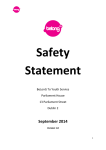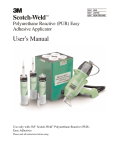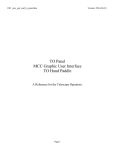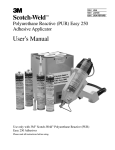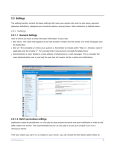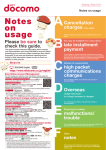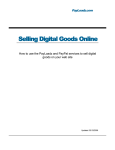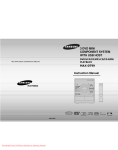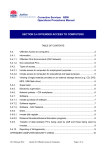Download How eBay Works
Transcript
N-CAP Users’ Guide Everything You Need to Know About Using the Internet! How eBay Works by Julia Layton In 2004, a South Florida woman listed a partially eaten grilled cheese sandwich on eBay. The sandwich sold to the highest bidder for $28,000. She believed, and showed in the auction's photos, that the sandwich had the image of the Virgin Mary in one of its slices of bread. EBay is a global phenomenon -- the world's largest garage sale, online shopping center, car dealer and auction site with 147 million registered users in 30 countries as of March 2005. You can find everything from encyclopedias to olives to snow boots to stereos to airplanes for sale. And if you stumble on it before the eBay overseers do, you might even find a human kidney or a virtual date. In this article, we'll find out how you can buy and sell items on eBay, examine how the bidding process works, look at ways you can protect yourself from auction fraud and take a look at the business and technology of the largest auction site in the world. 1 eBay Basics EBay is, first and foremost, an online auction site. You can browse through categories like Antiques, Boats, Clothing & Accessories, Computers & Networking, Jewelry & Watches and Video Games. When you see something you like, you click on the auction title and view the details, including pictures, descriptions, payment options and shipping information. If you have a pretty good idea of what you're looking for, you can search for it using simple keywords, such as "Apple iPod," or using more advanced search criteria that helps narrow the results, such as keywords to exclude, item location, price range and accepted payment methods. If you place a bid on an item, you enter a contractual agreement to buy it if you win the auction. All auctions have minimum starting bids, and some have a reserve price -- a secret minimum amount the seller is willing to accept for the item. If the bidding doesn't reach the reserve price, the seller doesn't have to part with the item. In addition to auctions, you can find tons of fixed-price items on eBay that make shopping there just like shopping at any other online marketplace. You see what you like, you buy it, you pay for it and you wait for it to arrive at your door. There are also auction listings that give you the option to "Buy it Now" for a price that's typically higher than the auction's start price. If you choose to buy the item for the "Buy it Now" price instead of bidding on it, the auction ends instantly and the item is yours. In this auction, the Starting Price is $8.99, and the Buy it Now price is $9.99. 2 You can pay for an item on eBay using a variety of methods, including money order, cashier's check, cash, personal check and electronic payment services like PayPal and BidPay. It's up to each seller to decide which payment methods he'll accept. PayPal is the easiest way to buy something on eBay, because eBay owns PayPal. The PayPal payment process is already built into any auction listing on eBay. Just as you can buy almost anything on eBay, you can sell almost anything, too. Using a simple listing process, you can put all of the junk in your basement up for sale to the highest bidder. Lots of people sell their old laptop once they've upgraded, the clothing their kids have grown out of or the brand new couch they bought on final sale without realizing it wouldn't fit in their den. Some people even make a business of eBay by opening their own "eBay store." When you sell an item on eBay, you pay listing fees and turn over a percentage of the final sale price to eBay. Once you register (for free) with eBay, you can access all of your eBay buying and selling activities in a single location called "My eBay." You can view all of your eBay activities in My eBay. EBay is a massive operation with something like 4.8 million new listings per day. Before we learn more about how to buy and sell on eBay, let's find out how eBay manages this level of activity. eBay Infrastructure A series of service disruptions in 1999 caused real problems for eBay's business. Over the course of three days, overloaded servers intermittently shut down, meaning users couldn't check auctions, place bids or complete transactions during that period. Buyers, sellers and eBay were very unhappy, and a complete restructuring of eBay's technological architecture followed. 3 In 1999, eBay was one massive database server and a few separate systems running the search function. In 2005, eBay is about 200 database servers and 20 search servers. The architecture is a type of grid computing that allows for both error correction and growth. With the exception of the search function, everything about eBay can actually run on approximately 50 servers -- Web servers, application servers and data-storage systems. Each server has between six and 12 microprocessors. These 50 or so servers run separately, but they talk to each other, so everybody knows if there is a problem somewhere. EBay can simply add servers to the grid as the need arises. While the majority of the site can run on 50 servers, eBay has four times that. The 200 servers are housed in sets of 50 in four locations, all in the United States. When you're using eBay, you may be talking to any one of those locations at any time -- they all store the same data. If one of the systems crashes, there are three others to pick up the slack. When you're on the eBay Web site and you click on a listing for a Persian rug, your computer talks to Web servers, which talk to application servers, which pull data from storage servers so you can find out what the latest bid price is and how much time is left in the auction. eBay has local partners in many countries who deliver eBay's static data to cut down on download time, and there are monitoring systems in 45 cities around the world that constantly scan for problems in the network. This infrastructure lets millions of people search for, buy and sell items simultaneously. On the user end, it all works seamlessly. Let's try it out. 4 Using eBay: Browsing for Items The best way to learn how to use eBay is to dive right in. What do you feel like looking for today? A surround-sound system? A mink stole? HowStuffWorks could use a Homer Simpson Pez dispenser. Let's look for one. There are two ways to go about finding a Homer Simpson Pez dispenser. We can browse, or we can search. Let's start by browsing -- it's the slower, more round-about method, but it's a good way to get a feel for eBay's category system. The most popular categories are listed right on the eBay homepage, on the left side. 5 Pez dispensers are typically considered collector items, so the Collectibles category is a good place to start browsing. If we click on the Collectibles link on the homepage, we end up at a page listing all of the Collectibles subcategories. At the very bottom of the page, you can see that there's actually a subcategory called Pez, Keychains, Promo Glasses, and within that subcategory is another subcategory called Pez. 6 That seems like a good fit. Clicking on "Pez" brings us to an auction-level page: On this page, you can see that: • There are 3,355 listings in the Pez category. • The listings are currently sorted by time, with the newest auctions first. • We can search within Pez listings. Since we're looking specifically for a Homer Simpson Pez dispenser, "Homer Simpson" is a good term to use to narrow the results. If we enter "Homer Simpson" in the search box directly above the listing, it's only going to search the Pez subcategory, not all of eBay (although you can search all of eBay using a dropdown menu in the category field). Here's what comes up: 7 Thirteen items isn't bad, but we might be able to find more. When you enter a search term and there are fewer results than you'd like, the first thing to do is go back up to the search field and check the box for "Search title and description." The first search we did checked only the auction titles for the term "Homer Simpson." Searching only titles is a good way to narrow your results if you know exactly what you're looking for and what most people call it -for example, if you're looking for a GPS receiver, it's a pretty safe bet that anyone selling one would put "GPS" in the title. On the other hand, someone selling a Homer Simpson Pez dispenser might not put "Homer Simpson" in the title -- she might put "Simpsons" or only "Homer." So now we're going to search entire auction descriptions, which typically returns more results: We now have 23 listings to look through. But there is a much faster way to get to the place we've ended up at. If you're just looking for a bargain on some type of collectible, browsing is the way to go; but if you're looking for something specific, the eBay search function is the quickest way to it. 8 Using eBay: Searching for Items At the top of the eBay homepage, there's a search box where we can enter what we're looking for. Here's what comes up in our simple keyword search: Our simple keyword search delivered nine matches. When you do a simple search, the auction results page also tells you which categories your results are in. You'll notice that there are matches for Homer Simpson Pez dispensers in other places besides the Pez category. So when we search both titles and descriptions, we end up with 25 results -- more than we did when we were browsing. There's a listing about halfway down the page for a full set of Simpsons Pez dispensers, including Homer, with a starting price of just 99 cents. 9 That seems like a good deal. Here's the top of the auction page, where you'll find the basic auction stats: The starting price is low, the shipping price is reasonable, and the seller has 99.6% positive feedback. Always check the shipping price, as some sellers mislead buyers by selling the item for cheap and then making up the difference by severely overcharging for shipping, and always check the seller feedback. The feedback is how you know if you can trust the seller (and your feedback is how the seller knows he can trust you). We'll talk more about feedback in the next section, but for now, we just need to know that 99.6% positive feedback is a good sign. Since we're interested in this auction, we'll click on "Watch this item in My eBay" (top right of the auction page) so we can get back to it easily. Now it's in our watch list: In the next section, we'll bid on this item. 10 Searching Titles and Descriptions While searching titles and descriptions usually delivers more options, some of those options may be slightly off topic. This has to do with the way many sellers market their items. If a listing for a Batman Pez dispenser has a line in it that says "I'll also be listing several Homer Simpson t-shirts some time next week, so check back if you're interested," that's going to show up in our results, too. Some sellers also use a trick called "keyword spamming" to get more people to look at their auctions. They put a long list of the most popular search terms in their auction description so it turns up in the search results for any one of those terms. Using eBay: Buying Items To look for an item, you don't need to register -- you can browse, search and watch items (up to 10) as a guest. You can't bid or buy as a guest, though. So the next step is to register with eBay. It's quick and free. Now we can place a bid on the set of Simpsons Pez dispensers. If we click on the link in our watch list, we end up back at the auction page. There are four main sections to any auction page: • Title/Overview - This is where you see the basic information, like auction title, price, shipping price, seller information and how many bids have been placed so far. 11 • Description - This is where the seller provides details about the item. • Shipping, payment and return policy - This is where you can find full shipping information, any details the seller wants a bidder to know about making payment (including which methods are accepted) and what the seller's return policy is. 12 • Bidding - This is where you place a bid on the item. eBay's bidding process works like this: You enter the maximum amount you are willing to pay for the item, and eBay bids incrementally on your behalf until the bidding reaches the maximum amount you entered. So if we decide we are willing to pay $2.00 for this set of Pez dispensers, we enter $2.00 in the bid slot. 13 When we click "Place bid," the next screen is a confirmation screen where we can see the bid price and commit to it. Once we place and confirm our bid, here's what the auction page looks like: We are now the current high bidder. The top portion of the page with the blue background is for our eyes only -- no one else can see what our maximum bid is. Why is the current price $0.99 and not $2.00? It's because when you're the first bidder, no matter what you enter as your maximum price, your first bid is always the starting price. If someone bids against us, eBay will bid on our behalf up to $2.00 in $0.05 increments (low-price auctions use very small increments, while high price auctions use larger increments). So if another user comes along and enters $1.25 as his maximum, eBay will bid $1.31 on our behalf, and we'll still be winning. But if another user places a maximum bid of $2.01, we've been outbid (and eBay will send us an e-mail to this effect in case we're not watching the auction). At this point, if we still want these Pez dispensers, we have to enter a new maximum bid. This is where eBay's bidding process doesn't work exactly like it's supposed to -- and starts to get exciting. If every bidder truly entered the maximum he was willing to pay, auctions would end with little fanfare. The person who entered the highest maximum bid would quietly win. But humans being human, the actual maximum amount they're willing to pay is usually "a tiny bit more than what everyone who's bidding against me is willing to pay." If we still want our Pez dispensers, we'll enter a new maximum bid of, say, $3.00; and as long as the other bidder's maximum amount is less than $3.00, we'll be winning the auction again. Our coup might be temporary, though, because if the other bidder wants these Pez dispensers as much as we do, he's going to bid again until he outbids our maximum. And now we have a bidding war. Bidding wars are a rush -- and they're sometimes very expensive. If this war continues for the three days until the auction ends, we could end up paying a hundred bucks for these Pez dispensers. It happens. The adrenaline takes over and people start bidding to win -- not necessarily to win a few Pez dispensers, just to WIN. For this reason, most of the bidding happens in the last two minutes of an auction. People wait to place a bid until an auction is about to close -- this way, they can catch other bidders off guard, and hopefully no one will get the chance to outbid them. The last 10 seconds of a bidding war often becomes a battle of bandwidth. Someone using a dial-up connection will never be able to place a winning bid in 10 seconds. Someone using a cable modem can place a winning bid in two seconds. There is at least one reason why someone would place a bid very early in the auction: to remove a "Buy it Now" option. Remember that when an auction item also has a "Buy it Now" 14 option, if someone decides to "Buy it Now" the auction is over. But the opposite is also true: As soon as someone bids on the item, the "Buy it Now" option disappears. If someone comes across an item she wants but she's not willing to pay the "Buy it Now" price, she'll enter the minimum starting bid just so another user doesn't come along and buy it out from under her. Feedback When talking about eBay or any other online auction site, one of the most common questions is "How can I trust the person I'm buying from?" The answer is "feedback." Buyers leave feedback for sellers and sellers leave feedback for buyers whenever they complete a transaction. Feedback can be positive, neutral or negative, and your feedback score is listed beside your username whenever you're involved in an eBay transaction. If you buy an item and never receive it, and the seller doesn't answer your email regarding the lost item, you leave negative feedback. If you sell an item and the winning bidder never pays, you leave negative feedback. If everything goes well, you leave positive feedback. When you're involved in a transaction with someone who has 99.9 percent positive feedback, you can be confident you're not going to get swindled. To learn more, visit the eBay Feedback Forum. Using eBay: Paying for Items If we win our Simpsons Pez dispensers, the next step is to pay for the item. The seller in this listing accepts two forms of payment: PayPal electronic payment or money order/cashier's check. Overall, there are typically four methods of payment you can use on eBay: • Cash • Personal check • Paper money order or cashier's check • Electronic payment Cash is simple but dangerous, because you have no recourse if it gets lost in the mail, and sending it by registered mail is just going to cost you more money. Personal checks are safer to send in the mail. The downside to paying by check is that once the check arrives, the seller usually waits for it to clear the bank before shipping your item, so it'll probably take you an extra couple of weeks to receive it. With money orders and cashier's checks, the wait time is shorter because there's nothing to clear. Electronic payment is the fastest method -practically instantaneous. Using sites likes PayPal, BidPay and WesternUnion.com, you can draw money from your bank account or credit card or purchase an electronic money order and send the payment to your seller over the Internet. The downside to e-payments is the risk factor involved in any online transfer of financial data. Once we complete payment, the seller will ship it to us. The auction states the shipping method as "Standard Flat Rate Shipping Service," which doesn't tell us much, so if we want to know more we'll have to ask the seller. We can do this using the "Ask seller a question" link in the Seller Information box at the top of the auction listing. Once we receive the item, our next step is to leave feedback. If the seller has met all of her obligations (If the auction stated a shipping timeframe, did the item arrive accordingly? Does the item match the seller's description?), then our feedback should be positive. If we are not satisfied that the seller met the standards for positive feedback, the next move is contact her 15 to try to resolve the issue. Always let a seller try to fix the situation before leaving negative feedback. Most of the time, all it takes is a simple e-mail exchange to solve a problem, and you can't retract negative feedback once you submit it. eBay Etiquette: Buyer Do's and Don'ts Do: • leave feedback for every transaction • pay within the seller's preferred timeframe • read the entire listing before asking questions Don't: • leave negative feedback before contacting the seller • leave rude feedback So far, we've searched for, bid on and paid for an item. Our next step is to sell one. Using eBay: What Can I Sell? You can sell almost anything on eBay -- almost, but not quite. You can't sell illegal items, like illicit drugs, or government-controlled products like liquor, tobacco, guns or prescription drugs. You can't sell lock-picking tools or surveillance equipment like wiretaps or hidden cameras. You can't sell human body parts or remains, like your extra kidney (that's been tried) or your dead uncle's foot, and you can't sell something that doesn't exist in some concrete form -- for instance, you can't sell your soul to the highest bidder. An eBay user named David Finn tried that and got shot down. Just for a glimpse into the complex nature of running a site like eBay, here's an excerpt from the letter Finn received from an eBay representative regarding the decision to pull the plug on his auction: If the soul does not exist, eBay could not allow the auctioning of the soul because there would be nothing to sell. However if the soul does exist, then in accordance with eBay's policy on human parts and remains we would not allow the auctioning of human souls. The soul would be considered human remains, although it is not specifically stated on the policy page... Source: http://www.randi.org/jr/121203jref.html For a complete list of no-no's, see What items may not be sold on eBay?. If your item is not listed anywhere in that section, it's probably okay to sell. The author has a refurbished Samsung Yepp MP3 player that she bought on eBay a couple of years ago and never uses. That's definitely OK to sell. In the next section, we'll list this MP3 player on eBay. 16 Using eBay: Selling Items We going to try to sell a refurbished Samsung Yepp MP3 player on eBay. To sell something on eBay, you don't need much -- a few descriptive details is about all it takes. And if your item is in tangible form, it's good to have a picture of it. If we click the "Sell" button at the top of the homepage, we arrive at the first step in the listing process: We don't have an eBay Store, so we're not going to be selling at a fixed price. And we're not advertising real estate. So we're going to choose "Online Auction." The next step is to choose the category we want our item in. MP3 players definitely belong in the consumer electronics category. At the bottom of this page, we can choose to list our item in a second category for an additional fee, but Consumer Electronics is the obvious place for buyers to look for an MP3 player, so we'll just stick with that. On the next page, we'll choose "MP3 Players" as our subcategory, "Samsung" as the brand and "Yepp" as the model. Now it's time to describe the MP3 player we're selling. 17 The field for the freestyle item description is at the bottom of the page. You don't need to know HTML unless you want to do something fancy with your description. If your description will look fine as a block of text, you don't need any HTML tags at all. If you want any font changes or spaces between paragraphs, you can use this simple HTML template, which includes a header setup and a few paragraph tags: <font size="+2">AUCTION TITLE</font> <p> ITEM DESCRIPTION <p> ADDITIONAL DETAILS <p> This is what we're going to paste into the description box: Spelling Counts When writing titles and descriptions, watch your spelling. If we misspell "MP3" as "MP#" by holding down the shift key for too long, the only people who will find our auction are the ones specifically searching for misspellings. People who find these items can get them for super-cheap because no one's there to bid against them. There are Web sites and programs whose sole purpose is to find misspelled auctions on eBay. There's a spell-check button on the "Describe Your Item" page. <font size="+2">Samsung Yepp 64 MB MP3 Digital Audio Player REFURB</font> <p> Up for auction is a refurbished Samsung Yepp model YP-30S MP3 player with 64 MB onboard memory. It's also a digital voice recorder. It measures about 2.5 inches tall, 1.75 inches wide and just over 0.5 inches deep. I bought it on eBay a couple of years ago but didn't end up using it much. On the outside, the player is immaculate, and as far I know it works. You can definitely load and listen to music and navigate through your MP3 files. Aside from that, I'm not sure because I never read the manual or tested its various functions. <p> Along with the player, you'll receive the user manual, installation CD, USB cable (not shown in picture) and carrying case with belt clip. <p> 18 Next, we'll set a starting price, decide if we want to provide a "Buy it Now" option and set the auction duration. A little research tells us that a brand new Samsung Yepp YP-30S is selling for about $90, and a refurbished one is selling for about $40. Since we can't say for sure that every function on this player works, we'll start the bidding low -- at $9.99. This is a good idea for several reasons: • It provides incentive for someone to buy this MP3 player even though the seller is somewhat uncertain as to its condition. • It lets people consider buying it just for parts. • It cuts down on the listing fee we'll be paying to eBay, because part of the listing fee is based on the starting price. Setting a reserve price, which is the lowest price at which you're willing to sell your item, costs extra, and it really only makes sense to set one when you're selling a high-value item. In that case, starting the bidding at the lowest price you're willing to accept would mean a very high listing fee, so you might start the bidding low but pay a small fee to set a reserve. We've chosen not to set a "Buy it Now" price because auctions are fun, and we've gone with the standard, 7-day auction that will start as soon as we submit our listing. Next, we're going to scroll down a bit and add a picture. 19 We're using eBay Basic Picture Services because we only have one picture to load, and the first picture is free. All we have to do is click "Browse," locate the picture on our hard drive and double-click the file. If you have only a few pictures and you're not selling 50 items a week, it makes sense to use eBay's system. Otherwise, you might want to look into the cost-effectiveness of going with your own image-hosting service. The rest of that page is filled with additional features that you can purchase for a fee, including bold-face type for your title, a fancy frame for your listing and a spot in the "Featured Items" box that begins any list of search results. We're going to pass up those extras in order to keep our listing price down. On the next page, we choose our payment methods and set our shipping fee. We're going to make this a PayPal-only auction to keep it simple (and because the author already has a PayPal account), and we'll estimate our shipping cost so buyers know up front what they'll be paying if they win. We could also wait and send the winning bidder the shipping cost once we know his zip code, or we could set up a shipping calculator that allows the buyer to enter his zip code and find out the exact shipping charge. A seller can ship using any carrier, including the U.S. Postal Service, UPS and FedEx, or the seller can let the buyer choose the shipping method once the auction ends. 20 At the bottom of this page, we establish our return policy and provide any additional payment instructions if we have them: If we had other items up for auction at this time, we might use the "Payment instructions" box to let buyers know we'll combine shipping costs if they win another one of our items. Combined shipping is a good promotional technique. The final step is to review our listing details on the next page and make sure everything is correct. If not, we can makes changes and review it again. The bottom of this page shows our total listing fee: 21 eBay charges an insertion fee of $0.35 for starting prices between $1.00 and $9.99. We didn't purchase any additional features, so that's all it costs us to list this item. When someone buys the MP3 player, we'll also pay eBay a final-value fee. If it sells for $25.00 or less, the fee is 5.25 percent of the final sale price. For a complete list of seller fees, go to eBay.com Fees. Once we're satisfied that everything is correct, we officially submit the listing. Since we chose to start the listing immediately, it immediately shows up on the eBay Web site: Now we have an item for sale on eBay. The area with the blue background only shows up for us. We can make changes to the listing by clicking "Revise your item" as long as no one has placed a bid and there are more than 12 hours left in the auction. If at least one person places a bid before the auctions ends in seven days, we've got ourselves a buyer. When the auction is over, we'll send our buyer an invoice through eBay - it's basically a one-click process. We click on the "Send Invoice" button either on the auction page or in the sale-confirmation e-mail we receive from eBay, enter any payment details we did not already include in our listing, and hit "Send Invoice." Once we receive notification from PayPal that the buyer has sent his electronic payment, we'll ship the item to the buyer's confirmed PayPal address and leave positive feedback. Hopefully the buyer will also leave positive feedback once he has received his MP3 player in a timely fashion and finds it to be as we described it in the listing. Feedback is the best tool available for weeding out the bad sellers and backing up the good ones. Still, with all of the buying and selling that happens on eBay, all of it based on pictures and descriptions, fraud does happen. In the next section, we'll talk about some ways you can protect yourself from common schemes. Outcome: Second Time's the Charm On our first attempt, the MP3 player didn't get any bids. But all is not lost. We can relist it -- and if it sells the second time, we don't pay any relisting fee (but we do pay the final-value fee). If it doesn't sell, we have to pay the second $0.35 listing fee. Most likely, the problem is the sheer number of MP3 players listed on eBay -- on October 24, 2005, there are almost 17,000 listings in the "MP3 Players" category, many of them brand-new items in the gigabyte range listed by high-volume sellers at a starting price 22 of $0.99. It's hard to compete with that. Since our player is a lowvalue item (ancient in consumer electronics terms, refurbished and somewhat of a gamble), it's not cost effective to add any of the fee-based features that might make it stand out, such as boldface type or gallery status. So we'll give it another shot using some other techniques. For the second listing, we shortened the title a bit so it's easier to read and dropped the starting price down to $4.99. We made it clearer in the description that its basic functions do definitely work. This time, our item received three bids from two eBay users and sold for $15.50. Using eBay: Security The Internet in general is a hotbed of fraud schemes, and eBay is certainly a microcosm of the Internet. Anonymity provides an easy path to cheating people out of money. But while eBay users are anonymous on the surface, eBay almost always knows who they are. In most cases of fraud committed through eBay, the victims do have some recourse. In order to make buyers feel safer when making purchases on eBay, all tangible items are automatically insured for $200. A recipe that was supposed to be delivered to you via e-mail is not considered a tangible item. But if you purchased a set of speakers that never arrived, and you go through the dispute process and eBay determines you were defrauded, you can get your money back up to $200. As an incentive to use eBay's PayPal payment system, most items purchased through PayPal are covered up to $1,000. Buyer fraud is typically less damaging than seller fraud. The most common type of fraud a buyer can commit is simply not paying for an item. Sellers can deal with non-paying bidders by filing an Unpaid Item dispute. eBay will then attempt to contact the buyer and get her to pay. If she does not respond to eBay's attempts after eight days, the seller is reimbursed for eBay's cut of the final sale price and can relist the item for free. If the buyer does respond, the dispute can end in one of three ways: • The buyer decides to pay, and everybody's happy. • The buyer and the seller decide together to abandon the transaction, the seller gets reimbursed for the final-value fee and relists the item for free, and everybody's happy. • The seller decides not to deal with the buyer, the buyer gets an unpaid-item strike against her, and the seller gets reimbursed for the final-value fee and relists the item for free. In the end, the damage to the seller is relatively small. Another type of buyer fraud occurs when a buyer sends false payment. In most cases, this is in the form of a bounced check, and the seller finds out about it before shipping the item. Bounced checks are as common on eBay as they are in the rest of the world, and many sellers choose not to accept personal checks for this reason. Tips to avoid buyer fraud: • Always check the feedback of your bidders. If a user has excessive negative feedback, you may be able to cancel the bid. • If you accept a personal check as payment, never ship the merchandise until the check clears. • If your buyer doesn't pay, always leave negative feedback so the non-paying bidder has a harder time striking again. 23 Seller fraud is what what most people think about when they worry about using eBay. There are two main ways in which a buyer can be defrauded by a seller: The item the buyer purchased is dramatically different from how it was described in the listing; or the item simply never arrives. One thing to keep in mind when you think you've been defrauded is that miscommunication is common on eBay. For instance, if you didn't read every word of the auction listing for your item, you may have missed the part the said the seller would be out of town for three weeks and wouldn't be able to ship the item until she returned. This could be why you don't have your item and the seller isn't answering your e-mails. Also, e-mail is not the most straightforward form of communication. If your item hasn't arrived after two weeks, and you've e-mailed the seller but haven't heard back, it's a good idea to check your junk mail folder. Your seller may have sent a response e-mail that just never made it to your inbox. If there's nothing from the seller in your junk folder, you can request that eBay reveal your seller's phone number so you can give him a call and see what's going on. If you don't get an answer to your phone call (or if your seller lives in another country and it would cost too much money to call), your next step is to start the dispute process. When a buyer believes he has been defrauded, he can file a complaint, and eBay will work to solve the problem. (If you used PayPal, you should file a complaint there first, because your item is probably covered under PayPal's buyer protection policy and there's a separate system for that.) When you file a complaint in eBay's "Item Not Received or Significantly Not as Described" system, eBay will act as middle man between you and your seller to try to settle the dispute. If that fails, you can file a claim to get reimbursed for your purchase (but if you made your purchase using a credit card, you need to file a claim with your credit card company first -- eBay won't reimburse you if your credit card company is willing to). Tips to avoid seller fraud: • Always check seller feedback before placing a bid. • Ask all relevant questions before bidding on an auction. Some sellers think that if they don't say what condition the item is in, it's the buyer's fault if he bids on the item assuming it's in good condition and it turns out to be a piece of junk. • Always leave negative feedback for unscrupulous sellers -- this makes it harder for them to continue committing fraud. Fake escrow services are another way in which both buyers and sellers can be defrauded. See eBay Help: Using Escrow to learn about the safest way to use escrow for expensive purchases. These are the main methods of fraud committed through eBay, but there's another kind of eBay-related fraud that happens outside the eBay Web site. If you receive an e-mail from eBay asking you to update your account information, it's a good idea to be suspicious. Identity theft resulting from spoof e-mails that look like they're from eBay is a big problem. Many people know this scam as "phishing." These e-mails typically tell you that there is a problem with your credit card number stored on eBay, and unless you update your account information you won't be able to use the site. Sometimes there's an account information form in the e-mail itself, and sometimes there's a link that directs you to what looks like eBay's account information page but in fact is a spoof Web site. When you submit your account information, the scammer gets his hands on your credit card information and your eBay password. (PayPal spoofing is just as common as eBay spoofing, so you should be on the lookout for those e-mails, too. If you're aware of the problem, it's actually pretty easy to avoid getting scammed in this way. First, e-mails from eBay never include account information forms; second, even though the 24 link in the e-mail looks like an eBay URL, once you click on it, you can see in your browser's address bar that you're not at eBay at all. One fairly surefire way to avoid this type of scheme is by downloading the eBay security toolbar, which will simply tell you when you're at a fake site. If you find yourself the victim of one of these scams, and you've submitted your account information in a non-eBay form, you should immediately cancel the credit card number you provided and change your eBay password. In addition to using your credit card, these spoofers can use your eBay identity to cheat people, ruining your eBay reputation in the process. It's worth noting that you can also become the victim of identity theft simply by providing your credit card number in a seller's own checkout process. Most sellers who have their own checkout process are high-volume sellers with plenty of positive feedback (in the thousands). If you come across a seller with a low feedback number, be wary of providing your credit card information outside the eBay checkout system. Tips to avoid identity theft: • Know what a spoof looks like, and always check for the signs before providing any information. • Always report spoof e-mails to eBay. eBay will confirm that it's a spoof and investigate the incident. • Carefully check seller feedback before providing your credit card information in a seller's private checkout form. If you're diligent and careful, eBay can be a safe place to shop. Millions of people buy and sell on eBay with no problems at all, and as a result, eBay is thriving. In the next section, we'll take a look at the business of eBay, find out how it began and see what competition is out there. The Business of eBay EBay isn't the only online auction Web site, but it's by far the biggest. Yahoo!, Amazon and Overstock all have their own auction services, and others include uBid.com, AuctionFire.com and PoliceAuctions.com (where you can bid on government-seized property). There are also dozens of fledgling auction sites that offer free listing and other incentives to draw customers from eBay, but eBay continues to break records. Some people think eBay's success will ultimately lead to legal problems. With almost 5 million new listings per day, it's impossible for eBay to make sure none of them breaks a law. In 1999, eBay cancelled an auction for a human kidney (which had reached a bid price of $5.7 million) and several auctions for large firearms, including a rocket launcher and a bazooka. That year, eBay had 6 million registered users. Now it has 150 million. Although eBay prohibits the sale of human body parts and firearms, it's unclear what type of legal responsibility the company might have if one of those auctions were successfully completed. As of October 2005, eBay is looking at possible fines resulting from the alleged sale of prescription contact lenses on the site, even though "Prescription Drugs and Devices" are on eBay's list of prohibited items. Its astonishing reach may ultimately be its downfall, but for now, eBay remains the poster child for Internet success. 25 26



























